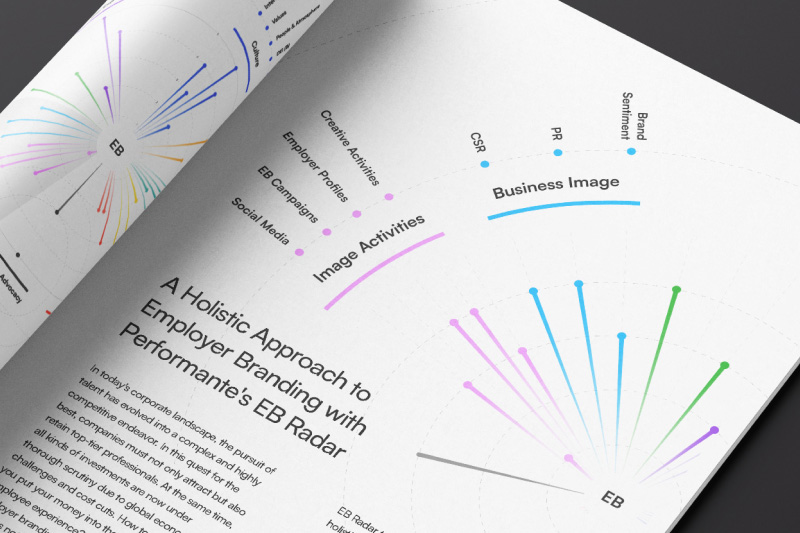I recently accepted the opportunity to join Performante, which represented an exciting challenge, not only because of the natural nerves of entering a new company and adapting to its culture but because it meant working with a team of experts in Employer Branding. It meant entering a world that, up until that moment, was unknown to me.
I am sure there are many professionals, as myself a few months ago, who still do not know what this branch of communication is about or how to address it within their companies. But I also know that delving into this topic has opened the doors to a fascinating world that has enormous potential to change the reality of many companies.
That’s why I decided to make a compilation of my first findings that is surely far from being the ultimate guide to Employer Branding but is, rather, an initial take of what I think anyone who starts exploring the subject should know. It has been an intense, exciting, and learning-filled period, but I will attempt to summarize my main findings. Who knows? Maybe I can save someone the time it took me to get to this point.
1. First things first: What is Employer Branding, and why should you care?
Let’s make it simple: you should care because, whether you like it or not, your company already has a brand as an employer, and the only thing you can do about it, is making sure it’s the right one.
Employer Branding is the image that you project as an employer to both the external and the internal public. That is, the reputation you have among your current employees and the idea that the potential candidates you would be interested in attracting have about you.

Becoming attractive to talent will help you recruit and retain the people who move the needle for your business. We are talking about those who are the most committed, productive, and capable of carrying out their tasks. And let’s not forget that your clients will also be exposed to your message, and they will build an expression about your culture and ways of work based on this. In other words, having a team who is satisfied with their work environment will translate into advantages for your business.
2. They are not your collaborators, they are your customers
It is clear that your company disburses the money at the end of the month, but what your employees give you in return has much more value. Add this to the fact that you’re not the only one who’s interested in them. There are very specific profiles that are coveted by many other companies. The odds of success in your employer brand strategy will increase as you assimilate this reality.
Make sure you know your audience. Find out what they want, what they need, what they care about. But also analyze what they fear, what they would not tolerate, and what they are tired of. Then, adapt your offer to their needs.
Don’t make your recruitment or your human management about your big company. You’d better start thinking about what you have to offer. A little humility will take you further.
3. Your company is not for everyone. Not everyone is for your company. And that’s perfectly fine.
No company survives if it hires the same profile for every role. The IT manager is as important as a developer or as the marketing director. You will need operational and administrative staff.
Your audience is diverse. And this is great! Having a variety of skills in your workforce is the perfect setting for development. However, you should keep in mind that different people will imply handling different needs. Your goal will be to make them believe in similar values but to let them know that they can (and should) keep their individuality.
Remember, your message should adapt to speak to all the profiles that interest you. However, you can’t and don’t need to attract everyone. Even though you will ideally attract many candidates, there are only a few people you will actually be able to hire. Define who you want to target and create your communication having them in mind. Always choose quality over quantity.
4. Your offer is not necessarily what you believe it should be
Within your company, people get a (good?) salary and professional development opportunities. All of that is perfect. But how many employers can offer the same? Or, if we put it another way, what do you have to offer that isn’t the same as what others provide?
Ask yourself what your real offer is. For this, it might help you to understand “that something” that talent seeks and you can offer, but your competition cannot. Only then will you become truly attractive as an employer. Remember that it’s not about offering what you think your audience wants, but about understanding what you have that fits what they’re looking for.
5. Talent deserves honesty
Your employer brand works just like a good portrait: it can exalt what’s right in you, but it can’t reflect something you’re not. Your message must be consistent with the reality that is lived within the company. Otherwise, you will constantly face issues related to early turnover, low productivity, and an unfavorable work environment, among others.
Keep in mind that some companies do not need to strengthen their employer branding strategy, but rather improve their work environment. It will be of no use to them to show themselves as the best place to work if their reality (and their workforce) says otherwise.
The best way to be consistent between what you communicate and what you actually offer is to consider all of your employees or at least a meaningful sample. Likely, you will not have the complete picture of your reality if you only count what the upper management or the human resources department have to say. So ask strategic questions, send surveys, and implement a strong feedback process. What should interest you is to know how your culture is perceived among people at all levels of the organizational chart. Even those who have just arrived count, since they will still remember the impressions that they had about you before starting their relationship with your company.

6. Your competition is not the one you are used to having
We are so used to saying that a brand that sells soft drinks competes with another that offers the same product. Or that the large phone companies are mortal enemies. Thus, companies operating in the same vertical seem destined to be rivals. But remember that, in Employer Branding, the customer is not the one who buys your product but the talent you want to recruit or retain. This way, it will be easier to conclude that your competition is not necessarily another company from your industry, but anyone who seeks the same profiles as you.
Both the big telephone company and the soft drink factory need accounting staff. And banks need customer service staff the same way a restaurant chain does. The battle for talents is amplified, so you have to prepare to excel. (And remember: gathering data from your employees will help you win the war!)
7. There is life after recruitment
Assimilating this point was harder than the others because I constantly found myself confusing recruitment marketing with employer branding. The reality is that Recruitment Marketing is only a part of Employer Branding and we are exploring a topic that goes far beyond the candidate experience. This is about considering the experience from the onboarding and then staying attentive to maintain consistency in internal communication, reinforcement of values, feedback culture, what employees transmit, and any other factor that can impact the way the world perceives your company.
On this point, I recommend reading Positive employee experience starts with a pleasant onboarding, where Tina Toutounchi, Team Leader of the Employer Branding department at Performante, explains the importance of the onboarding process and how to get the best out of it.
8. Those who leave count as much as those who stay
I left this topic for the end to reinforce it with the well-known phrase “last but not least…”. This is precisely the spirit I want to convey here: Just because an employee is about to leave a company and is having the last interactions with the rest of your workforce as co-workers, it doesn’t mean they become less important than the employees you’re trying to retain.
Whoever leaves is not only left with contacts within your company but is probably about to start a relationship with people who will define their idea of you from what this person shares with them. In addition, there are social networks, ratings, and a whole word-of-mouth culture that you will not be able to control. Therefore, it is convenient that your off-boarding process is as thoughtful as the welcome you gave from day one.
So far, I have learned that your Employer Branding depends on anyone who interacts with your company and sees you as a potential, current, or past employer. The experience you leave on each of them (and the data you gather) is relevant for you to achieve the right positioning. This is why you should make every interaction count.
I still have a long way to go but I’m confident that I’m surrounded by the right professionals to help me reach the advanced levels of this fascinating topic. Can you imagine what they could do for your brand?





